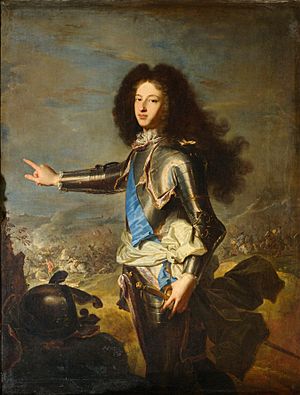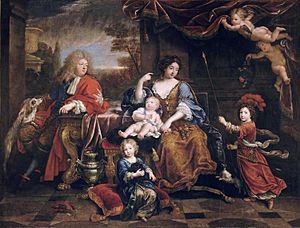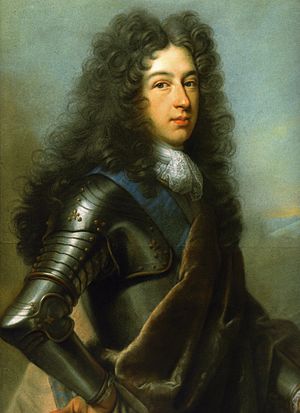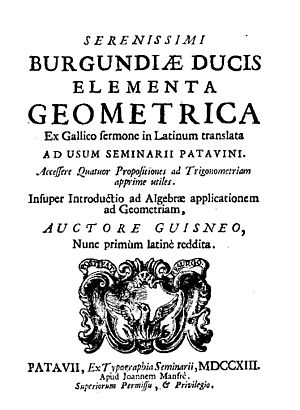Louis, Duke of Burgundy facts for kids
Quick facts for kids Louis |
|||||
|---|---|---|---|---|---|
| Dauphin of France Duke of Burgundy |
|||||

Portrait by Hyacinthe Rigaud, c. 1700-12
|
|||||
| Born | 6 August 1682 Palace of Versailles, France |
||||
| Died | 18 February 1712 (aged 29) Château de Marly, Marly, France |
||||
| Burial | 23 February 1712 Basilica of St Denis, France |
||||
| Spouse | |||||
| Issue Among others |
Louis, Duke of Brittany Louis XV of France |
||||
|
|||||
| House | Bourbon | ||||
| Father | Louis, Grand Dauphin | ||||
| Mother | Maria Anna Victoria of Bavaria | ||||
| Religion | Roman Catholicism | ||||
| Signature |  |
||||
Louis, Duke of Burgundy (born August 6, 1682 – died February 18, 1712), was an important prince in France. He was the eldest son of Louis, the Grand Dauphin, and Maria Anna Victoria of Bavaria. He was also the grandson of the powerful French king, Louis XIV.
People sometimes called him the "Petit Dauphin" to tell him apart from his father. When his father passed away in 1711, Louis became the official Dauphin of France. This meant he was next in line to become king. However, he never got to rule. He died in 1712 while his grandfather, Louis XIV, was still on the throne. After Louis XIV died in 1715, Louis's son became King Louis XV.
Contents
Growing Up in Versailles
Louis was born in 1682 at the grand Palace of Versailles. He was the first son of the French Dauphin, Louis, who was known as le Grand Dauphin. His mother was Maria Anna Victoria of Bavaria. His father was the eldest son of King Louis XIV and Queen Maria Theresa of Spain.
From birth, Louis received the title of Duke of Burgundy. As the son of the Dauphin and grandson of the king, he was a fils de France. This also meant he was second in line to the throne, right after his father.
Louis grew up with his two younger brothers. One was Philip, Duke of Anjou, who later became King Philip V of Spain. The other was Charles, Duke of Berry. A royal governess, Louise de Prie, looked after them. Louis was only eight years old when his mother died. His father, the Grand Dauphin, was not very interested in politics.
His Marriage
When Louis was 15, he married his cousin, Princess Marie-Adélaïde of Savoy. She was the daughter of Victor Amadeus II, Duke of Savoy. This marriage was part of a peace agreement called the Treaty of Turin. This treaty helped end conflicts between France and Savoy during the Nine Years' War. The wedding ceremony took place on December 7, 1697, at the Palace of Versailles.
Military and Politics
In 1702, when Louis was 20, his grandfather King Louis XIV gave him an important role. He was allowed to join the Conseil d'en haut, which was the High Council. This council handled important state secrets about religion, diplomacy, and war. His own father had only been allowed to join this council when he was 30.
In 1708, during the War of the Spanish Succession, Louis was put in charge of the army in Flanders. An experienced soldier, Louis Joseph, Duke of Vendôme, served under him. However, it was unclear who was truly in command, Louis or Vendôme. This confusion caused delays and meant they had to ask King Louis XIV for every decision.
Because of this indecision, the French army didn't act quickly. Messages had to travel a long way between the front lines and Versailles. This allowed the enemy forces to take advantage. The biggest problem was at the Battle of Oudenarde. Louis made some mistakes and didn't support Vendôme, which led to a big defeat for France. After this loss, his slow response to help the city of Lille meant the city was lost. This allowed the enemy to enter French territory for the first time.
Louis was influenced by a group of people known as the faction de Bourgogne. This group included his old teacher François Fénelon and his old governor Paul de Beauvilliers. These important nobles wanted the king to share power more. They believed that councils made up of aristocrats should help the king govern. If Louis had become king, he might have tried to make these changes.
Death and Legacy
Louis became the Dauphin of France after his father died in 1711. In February 1712, his wife, Marie Adélaïde, became very sick with measles. She died on February 12. Louis loved his wife very much and stayed by her side. He also caught the disease and died six days later, on February 18, at the Château de Marly. He was 29 years old.
Both of his young sons also caught measles. The older son, Louis, Duke of Brittany, died on March 8. This left his younger brother, a two-year-old boy, as the next in line to the throne. This young boy later became King Louis XV.
At the time, many people thought this frail child would not survive. This created a worry about who would rule France next. The hopes of the faction de Bourgogne (the group of nobles who wanted to change how France was governed) were also lost overnight.
However, some of their ideas were used later. When the Duke of Orléans became regent (ruler while Louis XV was too young), he tried a new system. He replaced ministries with councils made up of nobles. But this system didn't work well because the nobles often argued and were not always present. So, it was soon stopped in 1718, and France returned to an absolute monarchy.
Issue
- Louis, Duke of Brittany (June 25, 1704 – April 13, 1705) died young.
- Louis, Duke of Brittany (January 8, 1707 – March 8, 1712) died from measles.
- Louis XV of France (February 15, 1710 – May 10, 1774) later became King of France.
See also
 In Spanish: Luis de Francia (1682-1712) para niños
In Spanish: Luis de Francia (1682-1712) para niños




